The Turbine concept
When succeeding in capturing the enormous forces in slow moving currents, the reward is a stable delivery of power 24/7 unlike almost all other renewable energy concepts.

The Ocean Energy Turbine concept
The Ocean Energy Turbine concept is based on a submerged platform where the energy is captured through a conveyor belt onto which there are shovels mounted. The shovels are shaped in a way that results in high drag force and low turbulence. (This is a new patented solution in version 3 of the platform. The animation in this presentation shows version 2 of the platform without the newly patented shovel design).
The shape of the platform allows for a Bernoulli effect to take place (similar concept to what happens on an airplane wing) where the velocity of the water increases in the flow around the platform. This in turn increases the force applied to the shovel on the conveyor belts. The forces are transferred from the conveyor belts onto large cogwheels, like in a chain system. Furthermore, these cogwheels are connected to la large axle which transfers the forces to the generators on the top deck of the platform via a gearbox. From the generators the electricity is connected to the main grid via a cable running to shore.
The conveyor belt in the turbine is mounted on rails. To minimize the frictional forces on the rails the shovels are designed as a hollow sandwich to obtain the optimal buoyancy. The constantly moving shovels are also much less prone to biofouling compared to other concepts associated with ocean and tidal currents.
It is the intention of our system that the platform will either produce electrical energy to the grid, and/or produce hydrogen gas that can be delivered to the ship traffic directly – an energy tanking station for offshore vessels!
We envision a model where our platforms are deployed in clusters where the platforms are located close to each other without affecting the production capacity. 25 platforms in a cluster will provide a yearly production of approximately 4,5 TWh! This is comparable to the power output from an average nuclear power plant.
Environmentally friendly. The turbine is moving very slowly at 2 – 2,5 m/s (7,2 – 9 km/t or 4,5 – 5,6 mph) and represents no harm to marine life. The rotational speed of the cogwheels are approximately 1- 2 rpm. which greatly reduces the noise level compared to faster propeller-based systems.
The platform is extremely stable when submerged. A ballast tank system ensures most of the platform is filled with water and the low-relief profile is ideal to handle the strong forces generated by wind and waves. Furthermore, the turbines are not sensitive to wave movements in the splash zone. The visible is also much lower then conventional offshore turbines since most of the production platform is submerged in water.



New shaped shovels patented
This new patent, official 16th of March 2024 by The Norwegian Industrial Property Office (Patentstyret), makes a renewable energy revolution for ocean-, tidal- and river-currents! This patent consists of shovels that can stay in a row with very low turbulence between them. Full drag force on one side, very low turbulence on the other.

Testing of the concept
The main testing of the concept has been performed using state-of-the-art CFD (Computational Fluid Dynamics). In the rigorous testing process, we have optimized and tested nearly every conceivable combination which has resulted in the current design. The test results are described in detail in a 400 pages long report written by a 3rdparty consultancy specialist on computational fluid dynamics and turbine design.
In the last 5 – 10 years, advances in computational capabilities have seen CFD testing developed into the preferred method of accurately testing moving objects in water.
The next phase will however be to build a 20-meter pilot and deploy in a tidal current.


Mooring solution
When deployed the platform will experience challenging conditions with strong currents and drag forces.We are proposing to use a unique mooring solution utilizing modifications to known principles from offshore oil and gas development. A connection to large floater and a swivel base ensures that the platform always faces the direction of maximum current (kite principle) and provides elasticity to the ropes in order to prevent rupturing.
Mooring solutions in rivers
In rivers the platform will be fully submerged at the bottom and thus be “hidden” at the surface. The forces are suggested to be transferred ashore using hydraulic systems with the generators for electricity production placed along the river current in the most favorable location to minimize visibility.